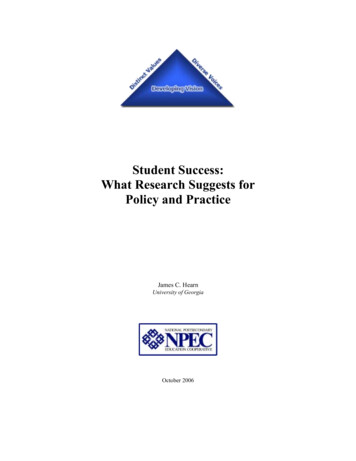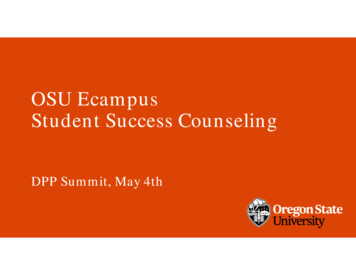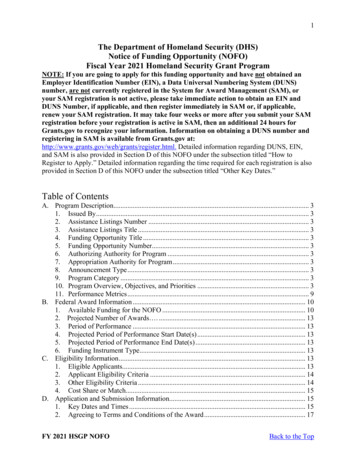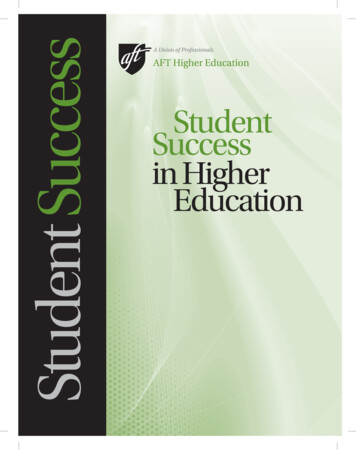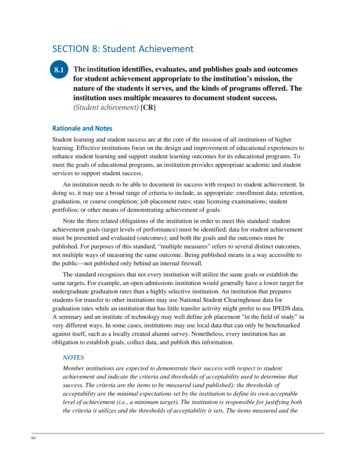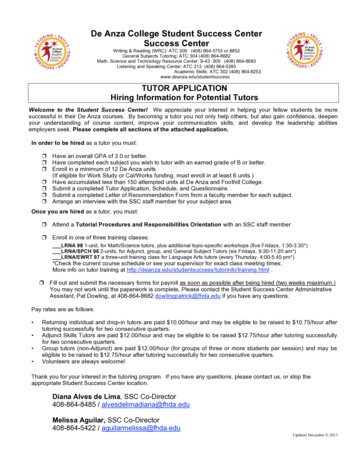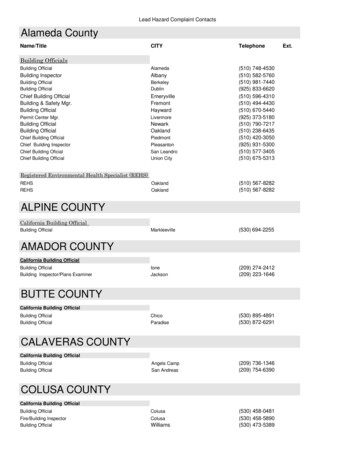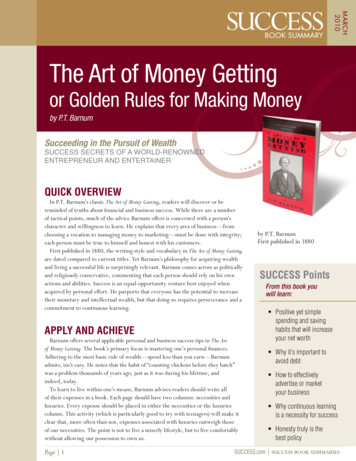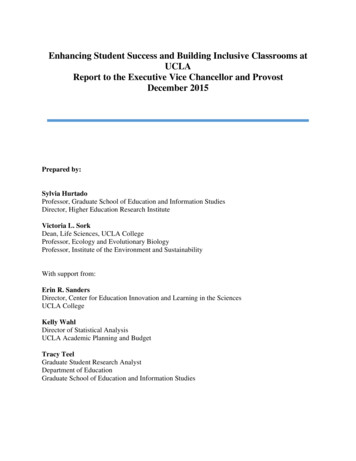
Transcription
Enhancing Student Success and Building Inclusive Classrooms atUCLAReport to the Executive Vice Chancellor and ProvostDecember 2015Prepared by:Sylvia HurtadoProfessor, Graduate School of Education and Information StudiesDirector, Higher Education Research InstituteVictoria L. SorkDean, Life Sciences, UCLA CollegeProfessor, Ecology and Evolutionary BiologyProfessor, Institute of the Environment and SustainabilityWith support from:Erin R. SandersDirector, Center for Education Innovation and Learning in the SciencesUCLA CollegeKelly WahlDirector of Statistical AnalysisUCLA Academic Planning and BudgetTracy TeelGraduate Student Research AnalystDepartment of EducationGraduate School of Education and Information Studies
ENHANCING STUDENT SUCCESS AND BUILDING INCLUSIVE CLASSROOMSTable of ContentsExecutive Summary .1I. Introduction .7II. Background: The UCLA Landscape – Who are our Students? .9III. Findings—Fail rates: Patterns and Factors Associated with Fail RatesA. What are the patterns of No-Pass rates? ----- 17B. What is the range of disparity among student comparison groups? ------------------------ 20C. Are grading patterns associated with disparities in student success? ---------------------- 29IV. Findings—Questionnaires: Department and IDP Chair Questionnaire, Course InstructorQuestionnaire, Faculty and Staff Consultation Meetings, and Student Programs InventoryA. Department and IDP Chair Questionnaire .35B. Course Instructors’ Course Data Questionnaire .36C. Academic Advisor and Faculty Consultations .38D. Inventory of Undergraduate Programs.40V. Campus Surveys: Student Learning Experiences and Perceptions of Classroom Climate .41VI. Recommendations.47VII. Concluding Remarks .57VIII. References .59
ENHANCING STUDENT SUCCESS AND BUILDING INCLUSIVE CLASSROOMSList of AppendicesA. The Charge Letter from the EVCB: Time-to-Degree Regression Models; Distribution of Course Offering No-Pass RatesC: Linear Regression Modeling: Course No-Pass RatesD: Course Offering Grading Distribution Cluster AnalysisE: Department and IDP Chair Questionnaire BriefF: Course Data Questionnaire to Course Instructors BriefG: Faculty and Staff Consultation Meetings BriefH: UCLA Faculty Survey and UCLA Senior Survey BriefI: Inventory of Student Support Programs
ENHANCING STUDENT SUCCESS AND BUILDING INCLUSIVE CLASSROOMS1Executive SummaryThe University of California Los Angeles (UCLA) faces a number of external pressures thatrequire a renewed commitment to excellence and diversity in undergraduate education. Forexample, California Governor Brown has urged campuses to decrease the overall time-to-degreeattainment and explore how undergraduates may complete the baccalaureate in three years.Businesses and government agencies also are calling for college graduates with skills to functionin a more diverse workforce. In the wake of the Moreno Report, which was commissioned byChancellor Gene Block and found faculty discrimination and bias in academic units, CaliforniaAttorney General Harris has asked the campus to address the climate for diversity and disparitiesin completion rates for underrepresented groups within a specified time frame. In comparisonwith other national universities, UCLA has yet to adopt inclusive excellence initiatives that makeuse of many advances in teaching, student learning, and assessment. Further, UCLA needs tofocus more efforts on transforming education in science, technology, engineering and math(STEM) fields to meet national goals (PCAST, 2012). If UCLA is committed to providing allstudents an equitable and inclusive learning experience in every discipline, it is important toaddress these issues, especially in light of increased undergraduate enrollments ( 600-700) in thenear future. At the request of Executive Vice Chancellor and Provost Scott Waugh, a workinggroup was tasked to identify areas of attention where UCLA could start to make changes thatwould have an immediate impact on improving the success of all students in the classroom. Thisself-study report and its recommendations are a first step towards building inclusive classroomsso that each student has an equal opportunity to succeed at UCLA.UCLA is characterized as one of the most selective public universities in the U.S., with a 20%acceptance rate. The mean high school grade point average (GPA) for first-year studentsentering in Fall 2014 was 4.3 and all demonstrate exemplary personal accomplishments and/orsignificant motivation to overcome obstacles. Suffice it to say that we have the most highlyqualified and uniquely talented students we have had in the history of the University. Thechanging demography of the state and the unequal opportunity for high quality education in K-12schools has created a context where the demographics of the California population, the UCLAundergraduate student body, and the faculty who teach them are highly discrepant. In particular,the UCLA faculty is majority male (65%) with only 11% underrepresented minorities (URMs),while the student body is 56% female with 24% URM. This discrepancy andunderrepresentation exacerbates the impact of implicit biases1 in the classroom based onracial/ethnic/gender/economic differences and the stereotype threat2 experienced by studentswhen they are in the minority in classroom settings. These potential problems can only beavoided by utilizing effective teaching practices now being implemented at major universitiesthroughout the country.This report of the working group has two main objectives, which focus on the teachingcomponent of student success in the classroom. First, our goal was to identify obstacles that are1Implicit bias “refers to the attitudes or stereotypes that affect our understanding, actions, and decisions in anunconscious manner.” In the classroom, unconscious attitudes and stereotypes may affect an instructor’sunderstanding of student behavior and result in an unfavorable assessment or disrespect. Stereotyping is moreprevalent in environments where students are underrepresented (Staats et al. 2015)2Identity or stereotype threat refers to being at risk of confirming, as self-characteristic, a negative stereotype aboutone's identity group such as race, gender or socioeconomic status, which has been shown to affect achievement(Steele and Aronson, 1995).
2ENHANCING STUDENT SUCCESShampering students’ progress towards a bachelor’s degree, with an emphasis on the achievementgap among groups of students, specifically URMs versus other students, students with PellGrants versus non-Pell students, and between male and female students. Second, we were askedto make recommendations that could have early beneficial impacts on student success that couldbe directed to the EVC, deans, department chairs, and course instructors.Given the size of the UCLA student body and that 81% of UCLA students had more than halftheir course schedules filled with large classes, we focused on courses with 50 or more students.To describe patterns of student success, we utilized the campus database of course grades toanalyze grading patterns for the last two years for all course offerings with at least five URMs(N 2,689 courses). To gain more insight about departmental and course practices associatedwith those grading patterns, we conducted a short survey distributed to department chairs andfaculty teaching those courses. Recent student and faculty surveys also were analyzed to furtherexplore classroom experiences. Finally, to understand factors contributing to uneven studentsuccess, we met with selected groups with different perspectives: individuals working onintervention programs to enhance student success, academic advisors, and associate deans ordeans’ designees from every school or division.There are several key assumptions of this report. First, courses are offered so that all students canlearn, and UCLA is committed to offering a high quality educational experience with facultywho are outstanding educators and world-renowned scholars. Second, UCLA is a learningorganization that can benefit from regular self-study as well as knowledge about the latestadvances in teaching and learning. Carl Wieman (2015), recipient of the Nobel Prize in Physics,states “all the research in the past few decades has established strong correlations between thetype of STEM teaching practices used and both the amount of student learning achieved andcourse completion rates. These correlations have been shown to hold across a large range ofdifferent instructors and institutions.” In short, high fail rates at UCLA in specific coursesindicate low levels of student learning, which could be improved with more effective teachingpractices. The key findings follow: Overall fail rates: Despite the high achieving nature of our student body and faculty,UCLA has a large number of course offerings (34.2%) where 5% or more of the classreceives a non-passing grade of a D or F. This finding is based on analyses of courses withenrollments of over 50 students offered during the last two academic years. In this group,many courses had No-Pass rates exceeding 10% and some as high as 35%. Analyses showthat courses with high fail rates are distributed across upper and lower division courses,departments, and schools and divisions. Courses with particularly high fail rates deserveattention because they extend time to degree for many students and raise concerns aboutthe effectiveness of teaching. In investigating disparities in the distribution of passing grades, we found that URM andPell Grant recipients were more likely to receive a non-passing grade. However,multivariate analyses show that the strongest predictor of the URM failure rate in a courseis the failure rate of non-URMs, indicating an issue with teaching and assessment practicesthat affect all students in a given classroom. The disparity in achievement between groupsis particularly high in specific classes that are outliers compared with the campus norm, andis significantly higher in classes taught by non-ladder faculty versus ladder faculty,although this pattern varies across disciplines. While we identified courses of concern inspecific units and campus-wide, there appear to be no systematic methods to monitor
AND BUILDING INCLUSIVE CLASSROOMS3student progress nor are there departmental strategies to address these courses and improvelow levels of student learning. Findings from the chairs’ questionnaire indicate professors and lecturers receive fewincentives and limited opportunities to improve teaching methods and little feedback oneffectiveness, except course evaluations or occasional peer-review. Graduate teachingassistants receive little preparation on how to teach their discussion sections or what toteach so that their efforts complement course goals. Compared with many other campuses,very few efforts are in effect to help course instructors become more aware of factors thathave an impact on inclusive classroom environments, such as dealing with diversity in theclassroom, implicit bias, stereotype threat, and micro-aggressions. The grading practices in courses were associated with disparities in failure rates betweenstudent comparison groups. The analysis of the patterns of grade assignments across theselected courses resulted in several clusters of different kinds of grade distributions. Somegrading patterns were associated with smaller disparities between categories of students,but other grading patterns were associated with fewer A’s and B’s and more non-passinggrades between: URM versus non-URM students, Pell Grant recipients versus non-PellGrant recipients, and males versus females. Findings from the course surveys suggest that some faculty are grading according tocriteria of concept mastery, which aligns grades to student learning, while at the other endof the continuum, faculty assign grades based on the class distribution (called normreferenced grading or “grading on a curve”). It is this latter practice that is associated withthe greatest disparities across groups in course performance. Campus-wide surveys offered further insight: There are significant group differences inwhether students think course instructors were able to determine their level ofunderstanding of course material, and less than half of all students felt that theircontributions were valued in class. Males, non-URMs, and students in highersocioeconomic (SES) groups were more likely to report a higher comfort level withclassroom climate than females, URM and low-income students. Asian and AfricanAmericans were least likely to feel that their contributions were valued in class, althoughthey were somewhat more positive about the level of faculty concern for their progress.Faculty and student survey data also revealed different opinions regarding the level ofclassroom competition. Further research is necessary to understand variation in classroomclimate in course offerings at UCLA, as current data reveal only general perceptions.Many selective universities have achieved national recognition for their work in promotingteaching excellence and addressing diversity in the classroom as integral to their initiatives. Forexample, the Center for Research on Teaching and Learning (CRTL) at the University ofMichigan is the source of the most widely used book on Teaching Tips in higher education. TheCRTL trains instructors/faculty about diversity in the classroom and administers studentevaluations that include questions about diversity. They encourage the use of a variety ofeffective teaching practices and promote the scholarship of teaching. UC Berkeley offersdiversity coaching and consultations through its Multicultural Education Program in the divisionof Equity, Inclusion, and Diversity. Cornell University’s Center for Teaching Excellence offersextensive online resources and tips for inclusive teaching strategies, attending to classroomclimate, and improving students’ active learning in large classes. The University of WisconsinMadison has integrated inclusive excellence goals in all of its academic and administrative units.It hosts online learning communities via the Center for the Integration of Research, Teaching and
4ENHANCING STUDENT SUCCESSLearning (CIRTL) that focuses on building a national network of faculty at 21 universitiescommitted to advancing effective teaching practices for diverse learners. Moreover, manyinstitutions are using advanced data analytics and dashboard systems to monitor studentprogress, identify “bottleneck” courses for supplemental instruction, and use technology toprovide timely information to improve advising and advance students more quickly to degreecompletion. UCLA should optimize use of technology and research on teaching to advance acomprehensive strategy for improving inclusive excellence in teaching and learning.RECOMMENDATIONSRecommendation #1: Adopt a technology-supported dashboard system to monitor studentprogress, identify courses with high fail rates, and target responses to improve studentsuccess. At the current time, data are stored and show great potential to be mined forimproving practice; however, it is not possible for deans, chairs, and course instructors oradvisors to easily identify courses of concern where student performance is within thecampus-wide range of performance or is an outlier with high fail rates. The campus shouldimmediately adopt a data inquiry tool for deans and chairs that will be useful in identifyingcourses of concern within their units for review with respect to student progress, teachingquality, instructional and grading practices, discussion size, credit hours, instructor/teachingassistant (TA) preparedness, and other factors, to see whether improvements could beimplemented to advance student success. Such a tool is intended to provide timelyinformation needed within each unit for the dean or chair to assist faculty in improvingstudent learning, and for advisors to advance students towards the finish line. An additionalbenefit of this tool is that it will provide initial evidence for exploring courses and disciplineswhere UCLA can focus its effort to improve the effectiveness of pedagogical approaches.Students could benefit from an advanced tool that provides accurate course information andadvances academic planning. For example, before they register they could review courseevaluations, number of times the course is offered each year, the proportion of majors thattake the course, and estimate time-to-degree.Recommendation #2: Create a campus-wide awareness of evidence-based pedagogy andimplement effective pedagogy in undergraduate courses at UCLA. Evidence-basedpedagogical practices are empirically linked with student success and completion. One of thecurrent problems is that there is no repository of information on evidence-based teachingpractices or ongoing discussions on what works to improve student learning, making itdifficult to identify areas of faculty innovation in teaching and learning across campus. Thereare a variety of learner-centered approaches, backed by research, that can be incorporated incourse design, implementation, and assessment that focus on improving the success of allstudents. For example, “backward design” aligns assignments and content, basing grades ongoals/competencies set for student mastery and course objectives. Deans and departmentchairs should encourage faculty to document their teaching practices in review and promotionmaterials as an example of impact, make their teaching practices public in the same ways thatscholarship is made public, and/or share how they advance student learning in the classroom.Recommendation #3: Develop a campus-wide strategy to support faculty development andteaching assistant training for teaching in diverse classrooms. An inclusive education is onethat is based on the principles of equity and inclusion of all students, differences areacknowledged as contributions in the classroom, and individuals are respected for their beliefsand cultural practices. To provide students an inclusive education, UCLA faculty must bemade aware of those instructional practices that deter student success in ways that
AND BUILDING INCLUSIVE CLASSROOMS5disproportionately affect individuals who identify with traditionally underrepresented groupsin higher education or who are beset by socioeconomic challenges that can differ from theirpeers who have never encountered these challenges. If diversity is a core value at UCLA thenall faculty and instructors should learn how to create the optimal conditions for a dynamic,diverse learning environment. The EVC, Vice Provost/Dean for Undergraduate Education,Vice Chancellor for Equity, Diversity and Inclusion and academic deans need to mount acoordinated effort to develop an effective and sustained strategy for campus-wide diversityeducation and the adoption of inclusive excellence goals across all units.Recommendation #4: Engage in a campus-wide dialogue about methods of student assessmentand grading practices for effective student learning. The analyses of grading patterns in thisreport show the relationship between grading practices and student success and also revealthat certain grading patterns are associated with disparities across groups. Some of thepatterns are consistent with a criterion-referenced grading practice where students achievegrades based on their mastery of course learning objectives. Other grading patterns areconsistent with a practice where grades are assigned based on the normative classperformance (i.e. class ranking and grade quotas). This latter approach is associated withhigher fail rates and disparities across groups. One problem with the latter approach is thathow a student earns a grade is not transparent; his/her grade depends on how the whole classhas performed rather than what a student has learned. Developing a set of guidelines on bestpractices for grading could improve student success and level the playing field for allstudents. Faculty and department chairs should make grading practices transparent in allcourse syllabi and adopt grading and assessment practices that help students achieve courselearning goals.Recommendation #5: Explore further ways to enhance active learning in large classes andimprove discussion and laboratory sections so that they also incorporate practices forinclusive education. We analyzed large classes to determine factors that contribute to studentperformance outcomes. While the overall model indicated that not all large classes were aproblem, the separate models comparing student groups identified secondary section size asassociated with higher No-Pass rates. More importantly, when we analyzed the factorsassociated with the achievement gap between URM and non-URM students or Pell Awardrecipients and non-recipients, course size was a significant factor in disparity ratios. Given theconsiderable number of classes with large enrollment, how we teach these courses will make abig difference in student learning. Through the questionnaires, we learned that many classesdo not develop a pedagogical approach for discussion sections, that course instructors often donot meet with TA’s, and that TA’s lack critical training in effective and inclusive teachingmethods. Further research should explore how lecture and discussion/laboratory materialcould be integrated to enhance student learning. Deans and chairs need to work together withfaculty to assess problems associated with discussion or laboratory sections that also affectstudent success. Central teaching excellence initiatives should consistently deal withpedagogies for active learning and offer tips for instructors of large classes. The Chancellor’sOffice may need to provide additional resources for more teaching assistants or undergraduatelearning assistants to assist active learning activities.Recommendation #6: Improve accountability and recognition for good teaching. The AcademicSenate should consider new approaches and policies to improve the assessment of teaching oncampus, hold faculty and department chairs accountable for the quality of their courses indepartmental reviews, and reward improvement as part of the academic personnel process.
6ENHANCING STUDENT SUCCESSOne way to improve accountability is to develop new criteria for assessing teachingperformance. Rather than rely on student and peer evaluations, both of which yield limitedassessment of student learning3, contributions toward teaching should include practices thatresult in desired student outcomes. For example, assessment of the relationship of learningobjectives to the content of syllabi and concepts in examinations, papers or other assignments,as well as transparency of grading practices should be part of the evaluation system. Anotherexample is the effective use of teaching observation protocols by trained individuals that areused widely elsewhere and are now being tested on campus and rather than unstructuredobservations by peers. The Academic Senate also should consider rewarding faculty whoengage in activities to improve their teaching, scholarship on teaching, and mentoringactivities to promote student success.Recommendation #7: Advance a center for teaching excellence that will provideongoing/coordinated professional development opportunities and resources to learn bestpractices in teaching and inclusive education. Timely and regular information should beprovided to faculty to initiate the implementation of effective teaching techniques. Thisinformation could be delivered through online resources, workshops on campus, facultylearning communities focused on a technique or disciplinary advances in teaching, andsymposia to learn best practices for inclusive education. Such practices include: aligningcourse assessments and learning activities with student learning objectives; interactiveclassrooms; practices to avoid implicit biases in teaching and to reduce stereotype threatamong students; skills to handle micro-aggressions and conflict in the classroom; anddevelopment of transparent grading practices. The initial focus may be on recently hiredassistant professors, lecturers, teaching assistants, and instructors of large gateway4 courses orcourses with high fail rates. The implementation for this recommendation will requirecollaboration between the EVC, deans and faculty to establish a vision of a center that cancoordinate and disseminate resources, discipline-based activities, and ways to incentivizeparticipation of faculty, non-tenure track instructors and teaching assistants.The focus of this report is to identify areas for improving student success in the classroom,faculty teaching practices, and classroom climate. We assume that UCLA will continue to investin student interventions that address issues confronted by first generation college students,especially those coming from secondary schools where the quality of education and availabilityof advanced courses are less than what is offered at enriched, high-performing secondaryschools. We also assume that academic advisors will continue to strive to ensure that studentshave the appropriate background and prerequisites for the courses and majors they select, and weencourage further efforts to improve the effectiveness of advising to enhance student success.However, this study did not fully address this area. We hope this report will be widely sharedand that the campus uses these findings and recommendations to stimulate campus-widediscussion and exchange among deans, chairs, Academic Senate members, and class instructors.3Clayton’s (2009) meta-analysis reports that the correlation between measures of student learning and studentcourse evaluations has decreased over recent years and is very low. Peer evaluations have been quite variable,and unsystematic in implementation within and across units and divisions and are not linked with studentperformance at UCLA. Nor do these forms of evaluation of teaching quality provide information on inclusiveteaching practices.4A gateway course is defined as a course that is used as a prerequisite for a major that must be passed before astudent can continue to meet the requirements for a major. Any gateway course with a high fail rate can hamperprogress towards degree because students who do not pass the course must retake it before they can continue inmajor. If a student switches majors, then students often have to take new prerequisites.
AND BUILDING INCLUSIVE CLASSROOMS7I. IntroductionNational and economic concerns have focused on improving college attainments among anincreasingly diverse student population, shortening time to degree to reduce college costs, andrestoring America’s international competitiveness in STEM and a wide range of fields, asevidenced by national consensus panels and reports (PCAST, 2012). Businesses and governmentagencies are also calling for college graduates with skills to function in a more diverseworkforce. Not surprisingly, many federal and private funding opportunities have arisen tosupport the implementation of evidence-based practice to increase student learning and degreeattainments. These competitions for funds to support undergraduate education that holds promisein diversifying the workforce have raised the bar for institutions to demonstrate significantcampus-wide transformation in educational practices to achieve student learning goals and closeattainment gaps. The Association of American Colleges and Universities has long supportedcampuses in advancing student learning to meet 21st Century learning goals, encouraginginstitutions to embark on inclusive excellence initiatives that “require we uncover inequities instudent success, identify effective educational practices, and build such practices organically forsustained institutional change.”5 Faculty, deans and department chairs are central to this work,and there is a concerted effort to adopt a learner-centered paradigm on college and universitycampuses for increasing academic excellence.6On a more local level, UCLA faces a number of external pressures that require a renewedcommitment to excellence and diversity in undergraduate education. For example, GovernorBrown has urged campuses to decrease overall time-to-degree attainment and to explore howundergraduates may complete the baccalaureate in three years. In the wake of the MorenoReport, which identified faculty discrimination and bias in academic units, California AttorneyGeneral Harris has asked the campus to address the climate for diversity and disparities incompletion rates for underrepresented groups. Adding to this mix, UCLA is expecting toincrease resident undergraduate enrollments ( 600-700) in the near future. In comparison withother national universities, UCLA has yet to adopt inclusive excellence initiatives or utilizeadvances in teaching, student learning, and assessment. Recent success in large grantcompetitions for transforming education in STEM fields shoul
UCLA Report to the Executive Vice Chancellor and Provost December 2015 Prepared by: Sylvia Hurtado Professor, Graduate School of Education and Information Studies Director, Higher Education Research Institute Victoria L. Sork Dean, Life Sciences, UCLA College . Graduate School of Education and Information Studies . ENHANCING STUDENT SUCCESS .
